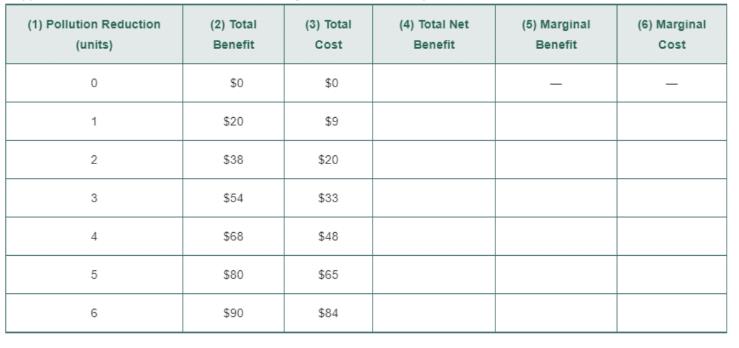
Suppose the total benefit and total cost to society of various levels of pollution reduction are as follows:

Complete column
Use total net benefit in column
Complete columns
Show that the Principle of Optimization at the Margin also implies that the EPA should require
Want to see the full answer?
Check out a sample textbook solution
Chapter 3 Solutions
MyLab Economics with Pearson eText -- Access Card -- for Microeconomics
- Which of the following statements is FALSE regarding common goods? Multiple Choice Water is an example of a common good. Similar to most public goods, the marginal cost of common goods is ALWAYS zero. Common goods are defined in economics as goods which are rival and non-excludable. Fish stocks in international waters is an example of a common good.arrow_forwardSuppose the Environmental Protection Agency (EPA) wants to mandate that all methane emissions must be reduced to zero in order to alleviate global warming in the United States. Which of the following describes why most economists would disagree with this policy? Reducing methane emissions is desirable, but whatever levels of pollution firms decide to emit privately are already efficient. Society would not benefit from lower air pollution. The environment isn’t worth protecting. The opportunity cost of zero pollution is much higher than its benefit.arrow_forwardFour individuals who live around a camp are hosting separate chirstmas parties, and all are considering purchasing aerial fireworks; any fireworks purchased will be set off over the camp, and thus will be visible to everyone at all of the parties. Karl’s marginal benefit from having an additional package of fireworks (which includes the benefit to himself and all of his guests) is given by MBK = 300 – 5Q, Jessica is given by MBJ = 600 – 10Q, Lara’s is given by MBL = 900 – 15Q, and Emily’s is given by MBE = 1,200 – 20Q, where Q is the total number of packages of fireworks set off at all parties. Each package of fireworks costs $800 (i.e., MC = 800). How many packages of fireworks will actually be set off if it is left to the free market? How much deadweight loss will result if this activity is left to the free market (as in part b)?arrow_forward
- The Centers for Disease Control and Prevention (CDC) has a new vaccine against a disease and are trying to determine the optimal percentage of the population that should be vaccinated. They do not recommend vaccinating the whole population against the smallpox virus because the vaccine has undesirable, and sometimes fatal, side effects. Suppose the following table gives the data about the effects of the vaccine. Percent of population Deaths Due to Deaths due to Marginal Marginal Cost vaccinated Disease vaccine side Benefit of the of the Vaccine effects Vaccine (extra (extra deaths lives saved by due to side vaccine) effects) 0% 200 0 NA NA 10% 180 10 20% 160 25 30% 140 55 40% 120 95 50% 100 140 60% 80 200 a. Calculate the Marginal Benefit (in terms of how many extra lives are saved by the…arrow_forwardThere are two people: Brandon, who is really, really good at cleaning front yards and mowing lawns; and Jim, who doesn’t have front yards or lawns in his current time and is worse than Brandon at both. In the course of a weekend, Brandon can clean ten front yards or mow five lawns. Jim, on the other hand, can clean only one front yard or mow only two lawns. Calculate the opportunity cost.arrow_forwardExplain why “tragedies” occur when the goods involved are common goods/resources. Explain how the Coase theorem may or may not resolve this problemarrow_forward
- Alice and Bob each produce haircuts and landscaping services. Alice can provide 4 haircuts in one hour. Bob can provide 2 haircuts in one hour. It takes Alice 2 hours to landscape an acre of property. It takes Bob 1 hour to landscape an acre of property. Assume Alice and Bob both work a standard 8 hour day. If Alice and Bob were to combine forces and open their business "Heads and Hedges" together, how should Alice and Bob allocate their time to maximize the gains from trade with one another? (check all that apply) Alice should only spend her time cutting hair. Bob should only spend his time cutting hair. Bob should only spend his time landscaping. Alice should only spend her time landscaping.arrow_forwardYou are considering whether you should go out to dinner at a restaurant with your friend. The meal is expected to cost you $40, you typically leave a 20% tip, and an Uber will cost you $5 to get there. You value the restaurant meal at $20. You enjoy your friend’s company and are willing to pay $30 just to spend an evening with her. If you did not go out to the restaurant, you would eat at home using groceries that cost you $8. How much are the benefits and costs associated with going out to dinner with your friend? Should you go out to dinner with your friend?arrow_forwardAlec and Ellie are the only detectives in the town of Broadchurch. They work together. Assume efficient production. Each has 10 hours in a day to allocate between conducting interviews and completing paperwork. Alec takes 25 hours to complete one interview or 4 hours to complete one file of paperwork. Ellie takes 15 hours to complete one interview or 20 hours to complete one file of paperwork. What is Alec's Opportunity Cost of an interview in terms of files of paperwork? Enter a number only. Note: The question here is asking you for the opp. cost in terms of files so you can just enter a number. On the assessments if the question is phrased as "what is the opportunity cost?", you will have to enter the units as well, without which you will not get full credit.arrow_forward
- Instructions: Once you’ve read Chapter 1: Limits, Alternatives, and Choices and Chapter 1 Appendix: Graphs and Their Meaning then read the scenario and find the solutions to the problems. Scenario: Suppose that you are on a desert island and possess exactly 20 coconuts. Your neighbor, Friday, is a fisherman, and he is willing to trade 2 fish for every 1 coconut that you are willing to give him. Another neighbor, Kwame, is also a fisherman, and he is willing to trade 3 fish for every 1 coconut. Problems: On a single figure, draw budget lines for trading with Friday and for trading with Kwame. (Put coconuts on the vertical axis.) Note: The budget line from trading with Friday (or Kwame) features a set of attainable combinations of coconuts and fish. What is the slope of the budget line from trading with Friday? What is the slope of the budget line from trading with Kwame?arrow_forwardUse the model of environmental pollution to model the following changes in a polluting industry to: i) the socially optimal level of pollution; ii) the total abatement costs; and ii) the total damage costs (а) A new technology is invented that allows firms to reducе pollution associated with each level of production output. (b) The government announces a new commitnment to more strictly enforce current environmental regulations. (c) A new study finds the pollutant in question to be more carcinogenic than originally thought.arrow_forwardIf the correct amount of pollution is being produced now, which of the following is true? The average cost of pollution: a. is exactly equal to the average cost of the pollution reduction.b. can be greater than, equal to, or less than the costs of pollution reduction.c. reduction is greater than the cost of the pollution at all levels of pollution.d. reduction is less than the cost of the pollution at all levels of pollution.arrow_forward



